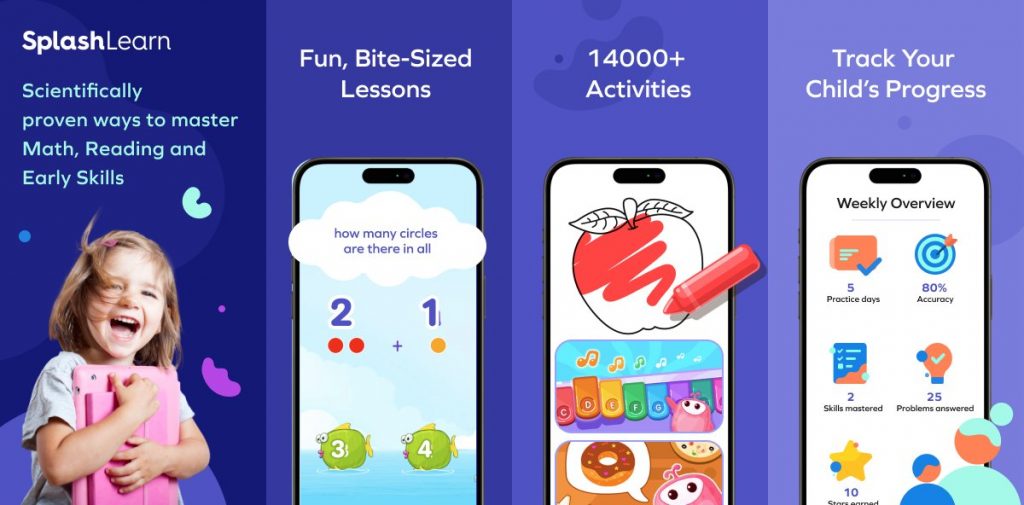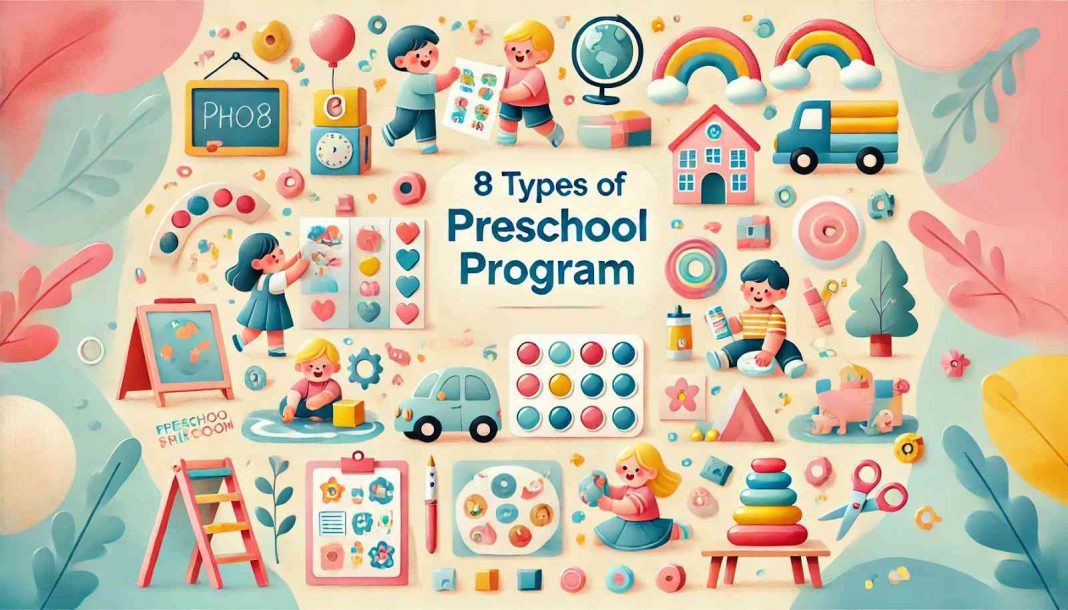Are you wondering what type of preschool program would be best for your child? Choosing the right preschool is a crucial step in your child’s early development, providing a structured environment for learning and growth. But with so many different preschool programs available, how do you know which one is the right fit for your child?
Math & ELA | PreK To Grade 5
Kids see fun.
You see real learning outcomes.
Watch your kids fall in love with math & reading through our scientifically designed curriculum.
Parents, try for free Teachers, use for free
In this blog, we’ll explore eight different types of preschool programs to help you find the best fit for your child’s needs and your family’s values.
What is Preschool Curriculum?
A preschool curriculum is a structured plan of activities and lessons designed to promote the development of young children. It includes various areas of learning such as language, math, science, social skills, and physical development. Preschool education aims to prepare children for kindergarten and beyond by fostering a love of learning and building foundational skills.
Related Reading: What Do Kids Learn in Preschool
Why is a Well-Rounded Preschool Curriculum Important?
- Encourages cognitive and emotional development.
- Promotes social skills and cooperation.
- Builds early literacy and numeracy skills.
- Supports physical development and motor skills.
- Enhances creativity and problem-solving abilities.
Pre-k programs with a well-rounded curriculum ensure that children receive a balanced education, helping them develop into well-rounded individuals.
8 Types of Preschool Programs
1. Montessori
The Montessori method is one of the well-known early childhood education program types. It focuses on child-led activities, allowing children to learn at their own pace in a prepared environment. This preschool type encourages independence and fosters a love of learning.
Key Characteristics:
- Child-led activities
- Mixed-age classrooms
- Hands-on learning materials
- Emphasis on independence and self-discipline
Benefits and Potential Drawbacks:
| Benefits | Potential Drawbacks |
|---|---|
| Promotes independence | May lack structure for some children |
| Encourages self-discipline | Can be expensive |
| Fosters a love of learning | May not suit all learning styles |
| Develops practical life skills | Limited social interaction with peers |
2. Play-Based
Play-based preschool programs are a common curriculum example for preschool, focusing on learning through play. These programs emphasize the importance of play in a child’s cognitive, social, emotional, and physical development.
Key Characteristics:
- Learning through play and exploration
- Child-centered and flexible
- Focus on social and emotional development
- Activities designed to promote creativity and problem-solving
Benefits and Potential Drawbacks:
| Benefits | Potential Drawbacks |
|---|---|
| Encourages creativity and imagination | May lack academic focus for some parents |
| Supports social and emotional growth | Less structured curriculum |
| Flexible and adaptive to children’s interests | Can be challenging to measure outcomes |
| Promotes a love of learning | May not suit all learning styles |
If you are looking for a play-based curriculum for your child, SplashLearn is a great option. SplashLearn offers a robust play-based curriculum designed to engage preschoolers in a fun and interactive learning experience. This curriculum seamlessly integrates foundational subjects like math, early reading, creativity, art, and critical thinking skills through play, making learning enjoyable and effective.
Why is SplashLearn a great preschool program:

- Comprehensive Play-Based Curriculum:
- Math Skills: Children learn number sense, addition, subtraction, shapes, and more through interactive math games and playful activities.
- Reading Skills: Alphabets, letter sounds, letter sequences, and sight words are taught using engaging and playful methods.
- Early Skills: Introduces general knowledge, art, creativity, and critical thinking through imaginative play and hands-on activities.
- Engaging Content Types: Over 10,000 fun and educational games that keep children engaged while they learn important concepts.
- Live Classes and Safe Interaction:
- Expert tutors conduct live, interactive classes using games and activities.
- These sessions provide a safe and fun learning environment without peer interaction, ensuring focus and safety.
- Flexible and Adaptive Learning Path:
- Daily recommendations fit seamlessly into your schedule.
- Allows selection of specific skills to focus on, providing flexibility to customize your child’s learning experience.
- Personalized Learning Experience:
- The curriculum adapts in complexity based on the child’s interactions and progress.
- Ensures content remains challenging yet accessible, maintaining an optimal learning curve through play.
- Progress Tracking and Insights:
- Detailed reports provide insights into your child’s activities and achievements.
- Offers tailored recommendations for further development, ensuring parents are always informed and involved.
3. Waldorf
The Waldorf approach is one of the unique types of preschool curriculums that integrates the arts and nature with academic learning. It focuses on holistic development, nurturing the child’s body, mind, and spirit through imaginative play and artistic expression.
Key Characteristics:
- Integration of arts, music, and nature
- Emphasis on imaginative play and creativity
- Consistent daily and weekly routines
- Focus on holistic development (emotional, social, intellectual)
Benefits and Potential Drawbacks:
| Benefits | Potential Drawbacks |
|---|---|
| Fosters creativity and imagination | May lack focus on academic skills |
| Promotes emotional and social development | Can be less structured for some children |
| Encourages connection with nature | Limited use of technology |
| Consistent routines provide security | May not suit all learning styles |
4. HighScope
HighScope is a well-researched curriculum example for preschool that uses a play-based approach. It emphasizes active participatory learning, where children have direct, hands-on experiences with people, objects, and events.
Key Characteristics:
- Play-based learning with active participation
- Consistent daily routine with plan-do-review sequence
- Focus on key developmental indicators (KDIs)
- Teacher and child interaction is encouraged
Benefits and Potential Drawbacks:
| Benefits | Potential Drawbacks |
|---|---|
| Promotes active learning | Requires extensive teacher training |
| Consistent routine aids security | May be resource-intensive |
| Encourages problem-solving skills | Can be less flexible |
| Focus on individual child’s growth | May not suit all learning styles |
5. Bank Street
The Bank Street approach encourages learning through play, social interaction, and exploration. It places a strong emphasis on emotional and social development, considering the whole child in the learning process.
Key Characteristics:
- Learning through play and exploration
- Emphasis on emotional and social development
- Child-centered and developmentally appropriate practices
- Teachers act as facilitators and guides
Benefits and Potential Drawbacks:
| Benefits | Potential Drawbacks |
|---|---|
| Supports emotional and social growth | May lack academic focus for some parents |
| Encourages exploration and curiosity | Requires skilled teachers |
| Child-centered approach | Can be challenging to implement |
| Flexible and adaptive curriculum | May not suit all learning styles |
6. Head Start
Head Start is a federally funded early childhood education program designed to promote school readiness for children from low-income families. It provides comprehensive education, health, nutrition, and parent involvement services.
Key Characteristics:
- Federally funded and free for eligible families
- Comprehensive services including health and nutrition
- Focus on school readiness and development
- Strong emphasis on parent involvement
Benefits and Potential Drawbacks:
| Benefits | Potential Drawbacks |
|---|---|
| Provides comprehensive services | Limited availability and funding |
| Supports low-income families | May have large class sizes |
| Emphasizes school readiness | Can be resource-intensive |
| Strong parent involvement | Variable quality across locations |
7. Reggio Emilia
Reggio Emilia is another distinct preschool type that emphasizes self-directed, experiential learning. This approach values the child as strong, capable, and resilient, rich with wonder and knowledge. Learning is based on the interests of the children.
Key Characteristics:
- Self-directed, experiential learning
- Relationship-driven environments
- Emphasis on collaboration and communication
- Use of the environment as a “third teacher”
Benefits and Potential Drawbacks:
| Benefits | Potential Drawbacks |
|---|---|
| Encourages creativity and critical thinking | Can be resource-intensive |
| Focuses on social development | May be challenging to implement |
| Values children’s interests | Less structured curriculum |
| Promotes collaborative learning | Requires highly trained educators |
8. Faith-Based Programs
Faith-based preschool programs integrate religious teachings and values with academic and social development activities. These programs provide a spiritual foundation alongside traditional educational experiences.
Key Characteristics:
- Incorporation of religious teachings and values
- Combination of academic and spiritual education
- Community and family-oriented environment
- Emphasis on moral and ethical development
Benefits and Potential Drawbacks:
| Benefits | Potential Drawbacks |
|---|---|
| Integrates spiritual and moral education | May not suit families of different faiths |
| Strong sense of community | Can be less diverse |
| Combines academic and religious learning | May focus less on secular subjects |
| Emphasizes values and ethics | Limited flexibility in curriculum |
Understanding these different preschool curriculums helps parents choose the best fit for their child, ensuring they receive a well-rounded early education that aligns with their family’s values and needs.
How To Choose a PreKindergarten Program?
- Know Your Child:
- Consider your child’s personality, learning style, and needs.
- Research:
- Understand different preschool curriculums.
- Visit Schools:
- Tour schools and observe classrooms.
- Meet the Teachers:
- Ensure staff are qualified and caring.
- Check Curriculum:
- Look for a balance of play and learning activities.
- Class Size:
- Smaller classes often mean more attention.
- Parent Involvement:
- Programs that involve parents can be beneficial.
- Logistics:
- Consider location, hours, and cost.
- Read Reviews:
- Look for feedback from other parents.
- Trust Your Instincts:
- Choose where you feel comfortable.
Conclusion
Choosing the right preschool for your child involves understanding various preschool types and finding the best curriculum examples for preschool that fit their needs. By exploring different options, you can ensure your child gets a strong start in their educational journey.
Related Reading: Best & Easy Activities for Preschoolers
Frequently Asked Questions (FAQs)
What age is best to start preschool?
Children typically start preschool between ages 3 and 4. This age is ideal as they begin developing social, emotional, and basic academic skills.
What program can I put my 3-year-old in?
For a 3-year-old, consider programs like Montessori, play-based, or Reggio Emilia. These preschool types focus on hands-on learning, social interaction, and developmental milestones suitable for young children.
























